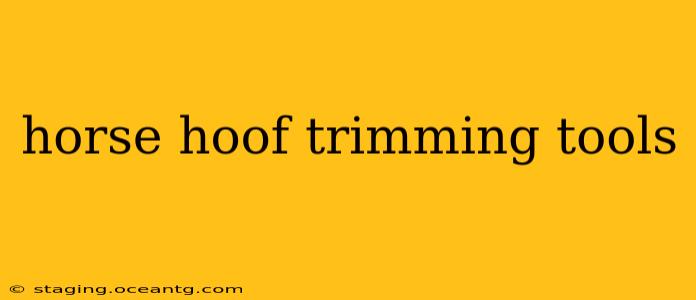Maintaining a horse's hooves is crucial for their overall health and well-being. Regular hoof trimming prevents lameness, improves balance, and promotes comfortable movement. While professional farriers are essential for routine hoof care, understanding the tools they use can help horse owners better care for their equine companions. This guide explores the essential tools used in horse hoof trimming, explaining their function and importance.
What Tools Do Farriers Use to Trim Horse Hooves?
Farriers utilize a variety of specialized tools to carefully and precisely trim a horse's hooves. These tools require skill and experience to use safely and effectively. Improper use can cause injury to both the horse and the handler.
1. Hoof Nippers:
These are arguably the most important tools in a farrier's kit. Hoof nippers come in various sizes and styles, each designed for specific trimming tasks. They're used to remove excess hoof wall, shaping and balancing the hoof.
- Types: Different nippers are suited for different hoof types and thicknesses. Some are designed for delicate work on thinner walls, while others are stronger for thicker hooves.
- Importance: Proper use of hoof nippers is vital for achieving a balanced hoof and preventing uneven wear.
2. Rasp:
After using nippers, a rasp is used to smooth the hoof wall and sole, removing any sharp edges or irregularities left behind by the nippers. Rasps come in various coarsenesses, with coarser rasps used for initial shaping and finer rasps for finishing.
- Types: Metal rasps are the most common, but some farriers also use electric rasps for faster work.
- Importance: The rasp ensures a smooth, even hoof surface, reducing the risk of injury to the horse and improving the overall hoof health.
3. Hoof Knife:
A hoof knife is a sharp, curved blade used to clean the hoof's frog and sole, removing debris, dirt, and loose material. It's also used to carefully trim away loose sole or frog material. A hoof knife is a very precise tool and must be used with caution to avoid harming the sensitive tissues within the hoof.
- Types: Different hoof knives have variations in blade shape and curvature, each tailored to specific tasks.
- Importance: Keeping the frog and sole clean is vital to maintain hoof health.
4. Hoof Picks:
Used before trimming to clean the hoof of dirt and debris, hoof picks are crucial for providing a clear view of the hoof's structure for accurate trimming. They come in various styles but all serve the purpose of removing dirt and revealing the hoof's true condition.
- Types: Metal hoof picks with varying handle lengths and shapes are the most commonly used.
- Importance: Ensuring a clean hoof before trimming allows for precise and safe hoof work.
5. Clinchers:
These tools are used to secure the shoes to the hoof after the shoeing process. Clinchers are not typically involved in trimming unless the horse is also being shod. They are only used by farriers experienced in shoeing.
- Types: Various clinchers are available, each designed for different shoe materials and thicknesses.
- Importance: Clinchers are necessary for securely attaching horseshoes.
How Often Should a Horse's Hooves Be Trimmed?
This depends on the horse's activity level, breed, and hoof growth rate. Generally, most horses need their hooves trimmed every 4-8 weeks. However, some horses may require more frequent trimming. A farrier can assess your horse's individual needs and develop a trimming schedule.
What are the Signs of Neglected Horse Hooves?
Neglected hooves can lead to severe problems, including lameness, cracks in the hoof wall, and infections. Signs of neglected hooves may include:
- Overgrown hoof wall: The hoof wall is significantly longer than it should be.
- Uneven hoof length and shape: One hoof is disproportionately larger or longer than the others.
- Cracks in the hoof wall: Cracks can indicate dehydration, improper trimming, or underlying hoof diseases.
- Lameness: This suggests pain and discomfort resulting from hoof problems.
- Signs of infection: Pus, swelling, or unusual odor around the hoof.
Regular hoof care, performed by a skilled farrier, is vital to prevent these problems. While this guide details the tools, remember that only a qualified professional should trim a horse’s hooves.
Can I Trim My Horse's Hooves Myself?
While many tools can be found online, it's strongly discouraged to trim your horse's hooves yourself unless you're a trained farrier. Improper hoof trimming can cause irreparable damage to the horse's hooves and lead to serious health problems. Always consult a professional farrier.
This guide provides a foundational understanding of the tools used in horse hoof trimming. Remember, this information is for educational purposes, and professional farrier services are crucial for maintaining your horse's hoof health.
